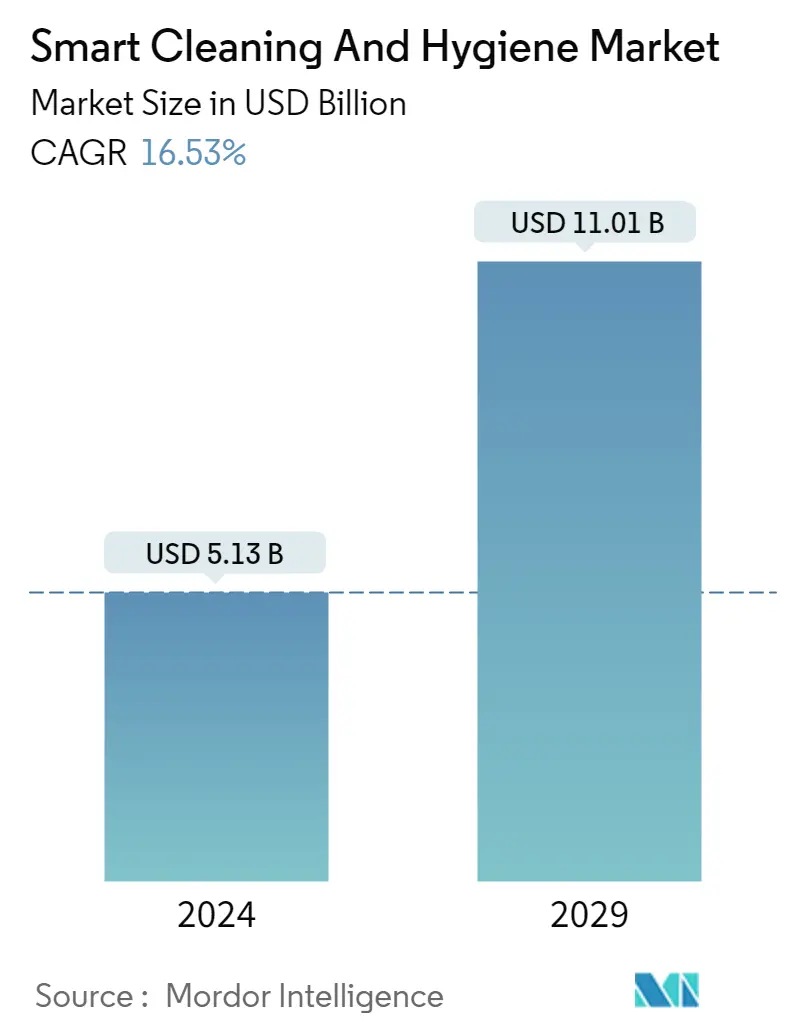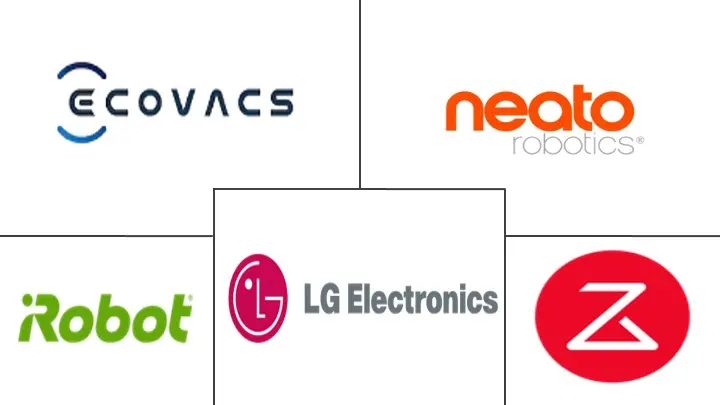Market Size of Smart Cleaning And Hygiene Industry

| Study Period | 2019 - 2029 |
| Market Size (2024) | USD 5.13 Billion |
| Market Size (2029) | USD 11.01 Billion |
| CAGR (2024 - 2029) | 16.53 % |
| Fastest Growing Market | Asia Pacific |
| Largest Market | Asia Pacific |
| Market Concentration | Medium |
Major Players
*Disclaimer: Major Players sorted in no particular order |
Smart Cleaning And Hygiene Market Analysis
The Smart Cleaning And Hygiene Market size is estimated at USD 5.13 billion in 2024, and is expected to reach USD 11.01 billion by 2029, growing at a CAGR of 16.53% during the forecast period (2024-2029).
Maintaining cleanliness is essential in all places, especially in hospitals. Around 50% to 70% of hospital-acquired infections (HAI) are spread through contaminated hands. Smart cleaning can help identify common touchpoints in hospitals and find the right solutions to eradicate all germs. Smart cleaning in the healthcare sector is essential to reduce diseases and improve the hospital's hygiene.
- The hospitality industry increasingly utilizes robotic technology to improve operations and enhance the guest experience. For instance, the Garden City Hotel in New York adopted Whiz by SoftBank Robotics' artificial intelligence (AI)-driven platform. The hotel staff claims it is convenient to use as they can keep the banquet hall furniture on one side and deploy Whiz to clean the carpets.
- In January 2023, Mero Technologies Inc received a fund of USD 1.5 million from the Canadian Government through the Jobs and Growth Fund. Mero offers smart cleaning solutions for commercial buildings to help measure building occupancy and cleanliness, helping tenants return to work safely. The funding will help Mero to expand its smart cleaning platform efforts into Western Canada and the US.
- The past two years saw a significant upheaval in the cleaning sector as the COVID-19 pandemic accelerated this transformation. The trend of smart cleaning became a necessity as it was a powerful incentive to get workers back into the office. Data-driven smart cleaning made it more efficient than ever for providers to offer a high-quality service that satisfies their customers. AI-integrated smart cleaning solutions enabled more efficient cleaning of meeting rooms and workspaces.
- Data security and protection will be a significant challenge for smart cleaning companies. Smart cleaning functions on data collected by sensors and protecting this data from breaching activities are equally important. For instance, a hacker can access the cameras of a cleaning robot and, in this way, gain knowledge of the internal floor plans of a building.
Smart Cleaning And Hygiene Industry Segmentation
The cleaning industry is undergoing a rapid evolution with the adoption of new technologies like the IoT and PropTech to improve their cleaning solutions. Soft service providers can now access networked, sensor-based point solutions, like intelligent trash cans and motion sensors that track occupancy levels and thresholds. It enables cleaners to schedule cleaning tasks more effectively, preventing overcleaning and saving resources. For instance, sensors can now monitor almost every touchpoint in restrooms, from motion detectors at the entrance to count the number of individuals that entered the restroom to sensors that gauge how full the trash cans, soap dispensers, and paper towel holders are.
The Smart Cleaning and Hygiene Market is segmented by product (robotic vacuum cleaner, pool cleaning robot, window cleaning robot, and other hygiene-based products) and geography (North America, Europe, Asia-Pacific, and the rest of the World). The market sizes and forecasts are provided regarding value (USD).
| Product | |
| Robotic Vacuum Cleaner | |
| Pool Cleaning Robot | |
| Window Cleaning Robot | |
| Other Hygiene-based Products |
| Geography | |
| North America | |
| Europe | |
| Asia-Pacific | |
| Rest of the World |
Smart Cleaning And Hygiene Market Size Summary
The smart cleaning and hygiene market is experiencing significant growth, driven by the increasing need for advanced cleaning solutions across various sectors, including healthcare and hospitality. The integration of artificial intelligence and robotics is transforming traditional cleaning methods, making them more efficient and effective. In healthcare, smart cleaning technologies are crucial for reducing hospital-acquired infections by identifying and sanitizing common touchpoints. The hospitality industry is also leveraging these technologies to enhance guest experiences and streamline operations, as seen in the adoption of AI-driven platforms like Whiz by SoftBank Robotics. The COVID-19 pandemic has further accelerated the adoption of smart cleaning solutions, emphasizing the importance of data-driven approaches to maintain high hygiene standards in workplaces.
The market is characterized by moderate competition, with numerous players offering innovative solutions to meet the growing demand. Companies like Neato Robotics, iRobot Corporation, and Ecovacs Robotics Co. Ltd are at the forefront, introducing advanced robotic cleaning systems that cater to both domestic and commercial needs. The Asia-Pacific region is emerging as a key player in the AI and robotics market, with countries like China and Japan leading in industrial robot supply and AI research. The region's investments in new technologies are expected to drive further growth in the smart cleaning sector. Additionally, partnerships and collaborations, such as those between SoftBank Robotics and Infogrid, are enhancing the capabilities of smart cleaning solutions, making them more appealing to businesses seeking to improve cleanliness and efficiency.
Smart Cleaning And Hygiene Market Size - Table of Contents
-
1. MARKET DYNAMICS
-
1.1 Market Overview
-
1.2 Industry Attractiveness - Porter's Five Forces Analysis
-
1.2.1 Bargaining Power of Suppliers
-
1.2.2 Bargaining Power of Consumers
-
1.2.3 Threat of New Entrants
-
1.2.4 Threat of Substitute Products
-
1.2.5 Intensity of Competitive Rivalry
-
-
1.3 Distribution Channel Analysis (Online vs Offline)
-
1.4 Market Drivers
-
1.4.1 Changing Consumer Preferences and Socio-economic Factors Along with Reduced Unit Prices
-
-
1.5 Market Restraints
-
1.5.1 Security Concern and Prevailing Pandemic Disrupt Supply Chain Activities
-
-
1.6 Assessment of Impact of COVID-19 on the Market
-
-
2. MARKET SEGMENTATION
-
2.1 Product
-
2.1.1 Robotic Vacuum Cleaner
-
2.1.2 Pool Cleaning Robot
-
2.1.3 Window Cleaning Robot
-
2.1.4 Other Hygiene-based Products
-
-
2.2 Geography
-
2.2.1 North America
-
2.2.2 Europe
-
2.2.3 Asia-Pacific
-
2.2.4 Rest of the World
-
-
Smart Cleaning And Hygiene Market Size FAQs
How big is the Smart Cleaning and Hygiene Market?
The Smart Cleaning and Hygiene Market size is expected to reach USD 5.13 billion in 2024 and grow at a CAGR of 16.53% to reach USD 11.01 billion by 2029.
What is the current Smart Cleaning and Hygiene Market size?
In 2024, the Smart Cleaning and Hygiene Market size is expected to reach USD 5.13 billion.

